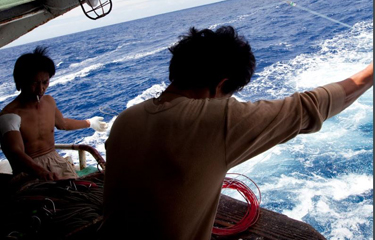Fishery products from China and Taiwan have been added to a list of commodities associated with forced labor in the latest edition of a US government report on child and forced labour globally.
The 2020 edition of the List of Goods Produced by Child Labor or Forced Labor – a report required by the Trafficking Victims Protection Reauthorization Act of 2005 – claims that the majority of workers on Chinese distant-water fishing vessels are migrants from Indonesia and the Philippines.
The report by the U.S. Department of Labor claims the Chinese distant-water fishing industry is using forced labor to catch the squid and tuna, which is shipped home to China for domestic consumption, as well as processing for sale to American and European buyers.
The report lists no reference to Chinese sources.
“According to media reports, the U.S. Department of State, and NGOs, numerous incidents of forced labor have been reported on Chinese fishing vessels,” the report said.
The listing comes as the United States is engaging in a broader pressure campaign against China in the latter days of the Trump administration. Organizations including Greenpeace USA, AFL-CIO, Human Rights Watch, Environmental Justice Foundation, and private companies such as Whole Foods Market have also called for greater scrutiny of China’s labor practices in its fishing industry.
The List of Goods Produced by Child Labor or Forced Labor report repeats previous assertions made by Greenpeace and in a 2018 investigative film released by the Environmental Justice Foundation detailing the testimonies of Filipino and Indonesian labourers on Taiwanese-owned fishing vessels who faced under-payment and non-payment of salaries and heavy financial deductions for food, travel, medical checks and accommodation.
In a one-paragraph explanation, the U.S. report flagged “reports that adults are forced to work in the production of fish on China’s distant-water fishing fleet.”
“It is estimated that there are tens of thousands of workers who are sometimes recruited by agencies that deceive workers with false information regarding their wages and the terms of the contracts, and require the workers to pay recruitment fees and sign debt contracts,” the report reads. “While on board the vessels, workers’ identity documents are often confiscated, the crew spends months at sea without stopping at a port of call, and they are forced to work 18 to 22 hours a day with little rest. Workers face hunger and dehydration, live in degrading and unhygienic conditions, are subjected to physical violence and verbal abuse, are prevented from leaving the vessel or ending their contracts.”
Labor could prove to be a difficult issue for China’s secretive distant-water fisheries sector, as the Chinese government both regulates and subsidizes the industry. Additionally, China is already facing accusations some of its fleet engages in illegal, unreported, and unregulated (IUU) fishing.
China’s size, economic heft, and diplomatic power make it a more difficult target than other countries accused of using forced labor and child labor to produce seafood (a list that includes Bangladesh, Brazil, Cambodia, Ghana, Indonesia, Kenya, Paraguay, Peru, The Philippines, Thailand, Uganda, Vietnam, and Yemen, among others). But the renewed U.S. pressure comes as China faces separate abuse claims from the European tuna industry, which has asked the E.U. to place anti-dumping duties on Chinese imports over claims that Chinese firms are unfairly subsidized and engage in illegal fishing. Similar pressure has proven effective in achieving change in other countries, including in Thailand, where reputational damage from allegations of slavery led the government to undertake significant reforms.
Unfair commercial threats may prove a potent stimulus for global government action against Chinese fishery firms, and the new U.S. report identifies fair commerce as a major problem caused by the use of forced labor.
“Coerced and unpaid labor isn't just a human rights concern – it can also give Chinese fisheries an advantage over rivals in an industry with geopolitical significance,” it said.
Increasingly, Chinese firms have been unable to fill out crew lists as its workforce shifts to better-paying industries, removing what had long been a competitive advantage of the country’s distant-water fleets. As a result, they are turning to hiring crew from poorer countries such as Indonesia and the Philippines, recruiting them via social media platforms like Weibo. Chinese companies operating in West Africa also frequently use locals as crew, though there is no reference in the U.S. report to that practice, which appears to be condoned by the Chinese government. To operate abroad, Chinese fishing companies must secure licenses from the Chinese Agriculture Ministry, which also regulates and inspects vessels. And Ghanaian crew members have reported abuse from their employers on-board Chinese fishing vessels.
Despite facing mounting difficulties as a result of questionable practices amongst its offshore fleet, China continues to back its growth. Data from several coastal regions this year so far seems to suggest a sustained increase in China’s distant-water sector, partially as a result of government support.
A document published in August by the Zhejiang Agriculture Bureau suggests that 220 distant-water vessels from the leading distant-water fishing port of Zhoushan landed 74,900 tons in the first half of the year, up 15.7 percent on the same period last year. Fishery output for the province of Zhejiang rose by 17.1 percent year-on-year in the first half of 2020, according to the provincial agriculture ministry office.
Fujian Province, another key source of China’s distant-water fleet, has been equally ebullient this year about its catch.
“Thanks to the renewal and transformation of ocean fishing vessels and the support of ocean [distant-water] fishing policies, ocean fishing output in the first half of the year was 216,900 tons, a year-on-year increase of 25.8 percent,” according to a new document the Fujian Ocean and Fisheries Bureau. The distant water catch data from the southeastern province of Fujian – the origin of numerous Chinese vessels fishing in West Africa and in Latin America – mirrors data from another region, Zhejiang, published last week.
Photo courtesy of Paul Hilton/Greenpeace







